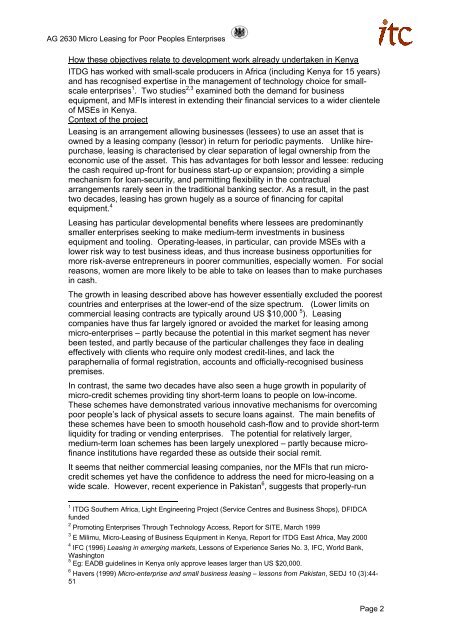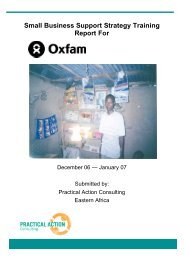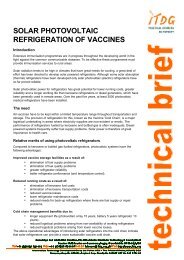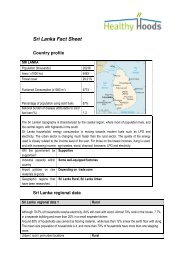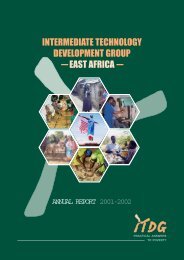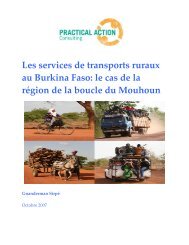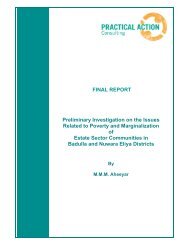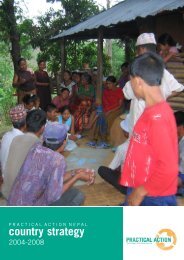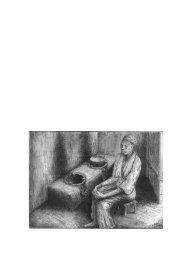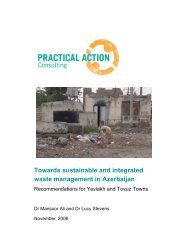Project Completion Report - Practical Action
Project Completion Report - Practical Action
Project Completion Report - Practical Action
Create successful ePaper yourself
Turn your PDF publications into a flip-book with our unique Google optimized e-Paper software.
AG 2630 Micro Leasing for Poor Peoples EnterprisesHow these objectives relate to development work already undertaken in KenyaITDG has worked with small-scale producers in Africa (including Kenya for 15 years)and has recognised expertise in the management of technology choice for smallscaleenterprises 1 . Two studies 2,3 examined both the demand for businessequipment, and MFIs interest in extending their financial services to a wider clienteleof MSEs in Kenya.Context of the projectLeasing is an arrangement allowing businesses (lessees) to use an asset that isowned by a leasing company (lessor) in return for periodic payments. Unlike hirepurchase,leasing is characterised by clear separation of legal ownership from theeconomic use of the asset. This has advantages for both lessor and lessee: reducingthe cash required up-front for business start-up or expansion; providing a simplemechanism for loan-security, and permitting flexibility in the contractualarrangements rarely seen in the traditional banking sector. As a result, in the pasttwo decades, leasing has grown hugely as a source of financing for capitalequipment. 4Leasing has particular developmental benefits where lessees are predominantlysmaller enterprises seeking to make medium-term investments in businessequipment and tooling. Operating-leases, in particular, can provide MSEs with alower risk way to test business ideas, and thus increase business opportunities formore risk-averse entrepreneurs in poorer communities, especially women. For socialreasons, women are more likely to be able to take on leases than to make purchasesin cash.The growth in leasing described above has however essentially excluded the poorestcountries and enterprises at the lower-end of the size spectrum. (Lower limits oncommercial leasing contracts are typically around US $10,000 5 ). Leasingcompanies have thus far largely ignored or avoided the market for leasing amongmicro-enterprises – partly because the potential in this market segment has neverbeen tested, and partly because of the particular challenges they face in dealingeffectively with clients who require only modest credit-lines, and lack theparaphernalia of formal registration, accounts and officially-recognised businesspremises.In contrast, the same two decades have also seen a huge growth in popularity ofmicro-credit schemes providing tiny short-term loans to people on low-income.These schemes have demonstrated various innovative mechanisms for overcomingpoor people’s lack of physical assets to secure loans against. The main benefits ofthese schemes have been to smooth household cash-flow and to provide short-termliquidity for trading or vending enterprises. The potential for relatively larger,medium-term loan schemes has been largely unexplored – partly because microfinanceinstitutions have regarded these as outside their social remit.It seems that neither commercial leasing companies, nor the MFIs that run microcreditschemes yet have the confidence to address the need for micro-leasing on awide scale. However, recent experience in Pakistan 6 , suggests that properly-run1 ITDG Southern Africa, Light Engineering <strong>Project</strong> (Service Centres and Business Shops), DFIDCAfunded2 Promoting Enterprises Through Technology Access, <strong>Report</strong> for SITE, March 19993 E Milimu, Micro-Leasing of Business Equipment in Kenya, <strong>Report</strong> for ITDG East Africa, May 20004 IFC (1996) Leasing in emerging markets, Lessons of Experience Series No. 3, IFC, World Bank,Washington5 Eg: EADB guidelines in Kenya only approve leases larger than US $20,000.6 Havers (1999) Micro-enterprise and small business leasing – lessons from Pakistan, SEDJ 10 (3):44-51Page 2


